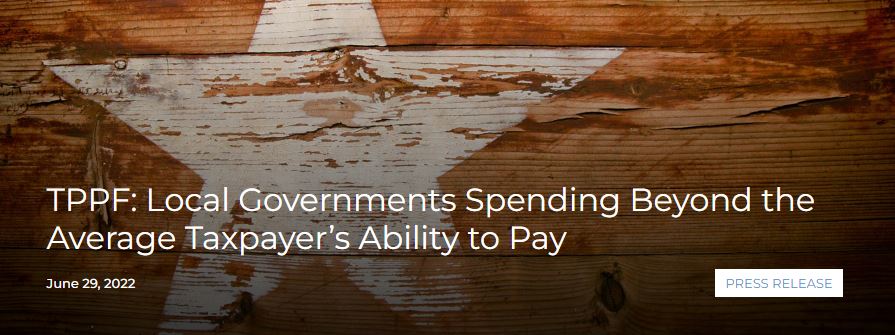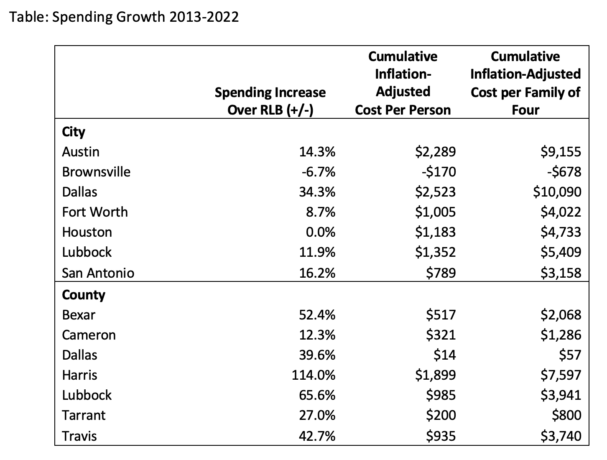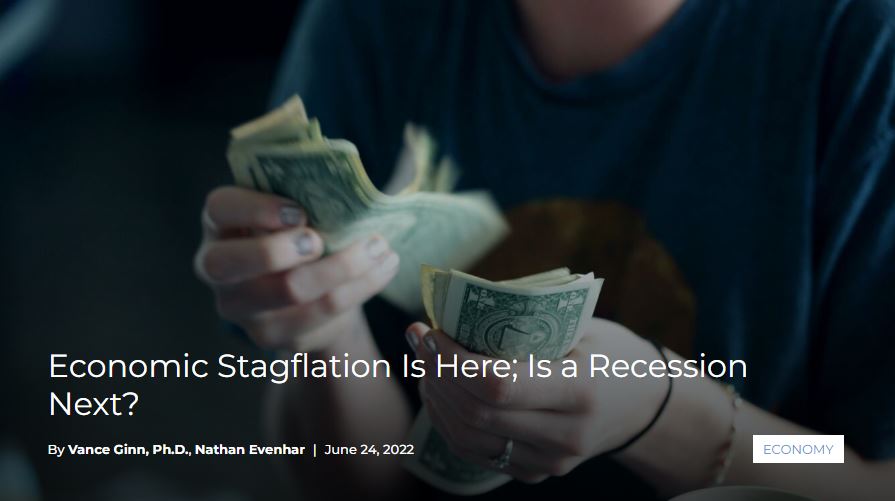Press Release for 7 Publications on Responsible Local Budgets for 7 Cities and Counties in Texas6/29/2022
Nearly every major city and county government in Texas spends well beyond what the average taxpayer can afford, according to a series of new research papers on local government spending by the Texas Public Policy Foundation. As a result, over the last decade the typical family of four has paid thousands of dollars in taxes over what the state considers to be a reasonable increase.
(Individual reports linked below) “Major cities and counties in Texas are spending huge sums that are wildly out of step with what many taxpayers can afford to pay,” said Dr. Vance Ginn, TPPF’s Chief Economist and co-author of the series. “The data should be a huge red flag that we are heading toward unsustainable spending growth and tax increases that kill jobs, punish families, and drive people and businesses out of the state.” TPPF defines reasonable spending growth as no more than population growth plus inflation. The state of Texas has followed this spending limit for state budgets for several biennia and officially adopted most of it into state statute in the last legislative session. City and county budgets are currently under no obligation to follow this reasonable spending limit. “Responsible Local Budgets (RLB) would promote efficiency and prudence with taxpayer money, creating less need for higher taxes and fees, but still provide all the funding needed for critical government functions,” said James Quintero, TPPF’s Policy Director for the Government for the People campaign and co-author of the research. “Taxpayers would love to see local governments voluntarily adopt these spending limits, but, as long as cities and counties continue their spending binge, it may be necessary for state lawmakers to impose strict parameters to protect taxpayers.” Over the last decade, Dallas has been the worst offender among cities, spending more than 34% above a responsible spending growth limit. In that time, the average family of four in Dallas paid more than $10,000 in excess taxes. The cities of San Antonio and Austin spent over 16% and 14% higher, respectively, than the average taxpayer’s ability to pay. Spending growth in Texas’ major counties has been eye-popping. Lubbock County’s spending has grown 66% above a responsible limit, Bexar County by 52%, Travis County by 43%, Dallas County by 40%, and Tarrant County by 27%. Only Brownsville spent under the growth limit during the decade. Harris County takes the prize as the worst of all local governments by exceeding a responsible spending limit by 114%. “Now it is time to rein in excessive government spending growth at the local level,” Ginn and Quintero write. “We urge local governments to voluntarily adopt these taxpayer protections. Because some may not, we recommend that the Texas Legislature pass a spending limit for all other local governments that includes all spending from any revenue source, restricts expenditure growth to a maximum of state population growth plus inflation from the prior year, and requires a two-thirds supermajority vote by the local governing body to exceed the limit.” “Limiting the growth of these budgets to population growth plus inflation with the RLBs outlined here will help ensure these localities can be vibrant places for people to prosper.” https://www.texaspolicy.com/press/tppf-local-governments-spending-beyond-the-average-taxpayers-ability-to-pay Since the severe spring 2020 shutdown recession, Texas has been a leader in economic recovery. This includes reaching new record highs in total nonfarm employment for 7 straight months, leading exports of technology products for 20 consecutive years, and being home to 54 of the Fortune 500 companies. Fortunately, the 87th Texas Legislature supported the recovery with the passage of many pro-growth policies like the nation’s strongest state spending limit, but there is more to do to remove barriers placed by state and local governments for Texans to reach their full potential. Solutions include governments passing responsible budgets and returning surplus tax dollars collected to taxpayers by reducing maintenance and operations property taxes until they are eliminated. Given the laboratory of competition in the U.S. system of federalism, other states are cutting, flattening, and phasing out taxes, so Texas must make bold reforms to support more opportunities for people to prosper, lower the rapidly rising costs of living, and withstand bad economic effects from policies out of D.C. https://www.texaspolicy.com/texaseconomy/ “We’ve had two quarters: 1.5% decline in GDP, that’s actually done the first quarter, and this quarter now is estimated by the Atlanta Fed as being very, very close to zero,” economist Art Laffer told Fox Business. “If it comes in negative, that will be the two quarters in a row—that would be the definition of recession.”
With the economy stagnating and inflation soaring, stagflation is here for the first time since the Great Inflation of the 1970s because of bad policies out of Washington. A recession is inevitable as the government-inflated “boom” busts—and we could already be in one. But pro-growth policies would help ease the pain. The pandemic prompted irresponsible and record-breaking deficit spending by Congress, pumping in massive “stimulus” funds that raised the national debt by $6 trillion to $30 trillion, or about $90,000 owed by every American. And President Biden has also been on a regulatory spree. His administration has finalized 360 rules through June 17 with a cost of about $215 billion, according to the American Action Forum. Compared to the same time since its inauguration, the Trump administration completed 367 rules at an economic cost of $1.2 billion. Those bad policies by Congress and the Biden administration have been a major reason why the economy is stagnating, with negative growth in the first quarter of 2022 and likely little to no growth in the second quarter. And the Fed purchasing that debt and printing too much money to chase too few goods resulted in a 40-year high in inflation. This stagflation affects employers and workers. Firms now can hold less inventory for the same amount they paid previously, which reduces their profitability and causes them to increase prices, cut costs, or reduce output to keep up with inflation. And consumers have less purchasing power. Workers and employers must then reduce their spending and investment, respectively. With workers producing less, productivity declined by at the fastest rate since 1947, contributing to why inflation-adjusted average hourly earnings are down substantially over the last year. Another issue is that safety-net programs were increased without work requirements during and since the pandemic. Those programs included expanding Medicaid, increasing child tax credits, and enhancing unemployment insurance payments. This has created even more dependency on government. And these expansions of government contributed to soaring deficit-spending with a 25% increase in the national debt in just the last two years. These handouts also encouraged people not to work because they would lose more in payments than they would receive from working. There are now 5.5 million more unfilled jobs than unemployed workers. In order to reduce the pain of the inevitable recession, Congress ought to adopt pro-growth policies, similar to those between 2017-2019. These policies included a concerted effort to reduce onerous regulations and to pass the Tax Cuts and Jobs Act. They contributed to the U.S. records of the lowest poverty rate (across most demographics) and the highest inflation-adjusted median household income. But excessive spending was an important factor that was missed then because Congress spent too much. If Congress just reined in spending to no more than population growth plus inflation, as outlined in the Foundation’s Responsible American Budget (RAB), the $20 trillion increase in the national debt over the last 20 years would instead have been a nearly $3 trillion surplus. This would have meant more money in Americans’ pocket and more economic growth from lower interest rates and less debt for the Fed to purchase to create inflation. Which is why the Fed also needs a monetary rule, which would call for it to have a much smaller balance sheet to reduce the quantity of money and a much higher federal funds rate target. Historically, the federal funds rate target must be as high or higher than the rate of inflation. With the latest inflation rate being 8.6% and the federal funds rate target being in a range of only 1.5%-1.75%, the rate target should be much higher. While this would likely result in a quick and deep recession, this is necessary given the government-inflated boom that must now bust. Bad policies have driven this government failure that’s making the situation worse before it gets better. For the sake of Americans, let’s end them now, because more government isn’t the solution. https://www.texaspolicy.com/economic-stagflation-is-here-is-a-recession-next/ The economic destruction from the shutdown recession from February to April 2020 and subsequent policy mistakes has been persistent. The labor market has improved but this is not a “booming economy.” Congress has added $6 trillion in deficit spending since January 2020 to reach the new high of $30.5 trillion national debt, which amounts to about $91,000 owed per American. And the Federal Reserve has monetized much of the new debt, leading to a 40-year high inflation rate. This has resulted in stagflation rearing its ugly head for the first time since the 1970s with rampant inflation and a stagnating economy, as output may decline in the first half of 2022. The Biden administration, Congress, and the Fed can correct this by not overregulating, overspending, and overprinting, respectively, but instead providing pro-growth policies for more productive private sector activity so that Americans can improve their livelihoods. https://www.texaspolicy.com/an-insiders-insight-on-todays-economy/ |
Vance Ginn, Ph.D.
|




 RSS Feed
RSS Feed